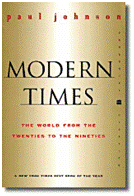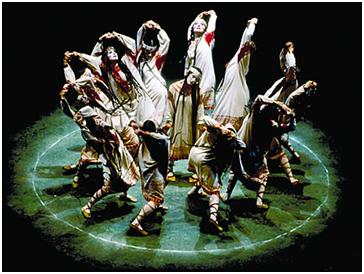 Every year for the past eight years, I have been teaching a course to high school seniors on Western Civilization from 1870 to the present. Every year for the past eight years, once we reach 1920, the text I have assigned for the course has been Paul Johnson’s Modern Times.
Every year for the past eight years, I have been teaching a course to high school seniors on Western Civilization from 1870 to the present. Every year for the past eight years, once we reach 1920, the text I have assigned for the course has been Paul Johnson’s Modern Times.
And every year for the past eight years as I re-read the text, I am astonished at what a tour-de-force Johnson’s history is. There simply is no other treatment of the 20th century which combines a narrative of events with a close analysis of the importance of ideas and worldview. Johnson clearly articulates a moral vision of the twentieth century in which the villains are those who perversely embody the “will to power” and who attempt to use political power to build “despotic utopias.”
This year, for the first two chapters, I found short video clips which I have been able to use effectively in class.
Johnson’s first chapter, A Relativistic World, focuses on the impact of Einstein & Freud (and to a lesser extent Marx & Nietzsche) on the popular mind from 1900-1920. He mentions, as one example of the widespread appeal & impact of moral relativism, the premier performance of Stravinsky’s Rite of Spring, commissioned by Sergei Diaghilev for the Ballets Russes of Paris, and choreographed by Nijinksy. The premier audience found the dance & music so provocative that a riot erupted among the audience as supporters and opponents of the piece attacked each other violently. The Paris Police were called before the first intermission and had difficulty restoring order. Part of the audience’s outrage was the staccato, dissonant nature of Stravinsky’s music, part was outrage at the jerky, non-traditional movements of the dancers choreographed by Nijinksky, and part was outrage at the storyline which tells of the pagan sacrifice of a virgin necessary to usher in spring.
It turns out that in 1987, the Joffrey Ballet recreated this 1913 premier performance using the original sets, costumes, and choreography.
AND, there is a YouTube video of the performance!
The first three minutes of the piece are melodically deceptive – and then the fun begins! My students watched with close attention, and understood the significance of the performance in a much deeper way than could be achieved simply by reading a description.
The second chapter in Modern Times is entitled, The First Despotic Utopias. Most histories of the twentieth century move rapidly from the end of World War One to the rise of Hitler in Germany. Johnson tells the story is greater detail and provides a much deeper understanding of the developments that preceded, foreshadowed, set the example, and paved the way for Hitler. The first despotic utopias were Russia under Lenin, and Italy under Mussolini. Lenin ruled Russia from the Revolution in 1917 until his death in 1922. Mussolini (who had been a socialist before World War One, and who studied Lenin’s revolution closely) sent his 40,000 blackshirt militiamen marching on Rome in October of 1922. Mussolini in the 1920’s was an impressive figure in world politics. Lenin’s Russia was widely admired in the European and American press for having achieved an economic miracle and laid the foundations for a “worker’s paradise.”
The successes of Lenin in 1917 and Mussolini in 1922 were what led Hitler to attempt to seize power in Munich in November, 1923. Without studying Lenin and Mussolini, one cannot understand why Hitler acted as he did, or what he hoped to achieve.
My students were puzzled by Lenin’s seizure of power. They had a hard time understanding how such a small party of communists wound up overthrowing the Tsar, the Duma, and seizing control of the Russian government.
In response to their questions, I played for them the following clip from Dr. Zhivago, which vividly illustrates the tactics of the communists in infiltrating the Tsarist army, encouraging desertion, mutiny, and the murder of the officers. After watching the clip, my students understood much better how and why the Revolution started in Russia.
The clip compresses the whole history of Russia’s involvement in World War One to about seven minutes. The opening monologue (by Alec Guiness playing a party member) is stunning:
“In bourgeoisie terms it was a war between the Allies and Germany. In Bolshevik terms it was a war between the Allied and German upper classes, and which of them won was a matter of indifference. I was ordered by the party to enlist. I gave my name as Petrov. They were shouting for victory all over Europe, praying for victory to the same God. My task, the party’s task, was to organize defeat. From defeat would spring the Revolution and the Revolution would be victory for us. The party looked to the conscript business. Most of them were in their first good pair of boots. When the boots wore out they’d be ready to listen. When the time came I was able to take three battalions with me out of the front line. The best days work I ever did.”
The clip shows starkly the anguish of the 900 mile Russian front and the suffering of the Russian army. By the second winter of the war, the boots had worn out. It then shows an encounter between a group of deserters and a company of replacements being led by their officers to the front. The deserters entice the replacements to join them. When they officers attempt to rally the troops, they are murdered.
From there it was just a matter of using the officer-less deserters to seize factories and city councils, and in a few short weeks, the entire Russian government.
My students understood.
– Rob Shearer
Publisher, Greenleaf Press
Director, Schaeffer Study Center
